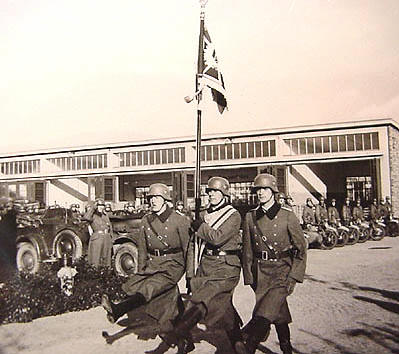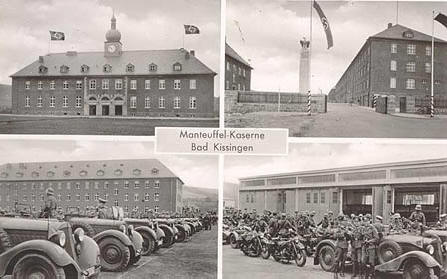| |
Saale Zeiting
Monday 18 October 1937
A Sunday at Our BarracksThe resurrected military finds its roots in both the old
traditions and latest developments of the modern era. The composition and
structure of the unit is matched with the new spirit of the military. The
fundamentals, guidelines, uniformity and foundations have changed. With the
blessings of the majority, the compulsory draft that rejuvenates the Fatherland
, brings our youth to the training areas and barracks, places that are not only
training sites and accommodations but also home to our youth for their two year
period of service. The barracks walls that once segregated the soldier’s life
have fallen, rather, this is a place that stresses the camaraderie developed in
the close partnership between the military and civilian population.
Bad Kissingen is proud of “her“ barracks, something that
with uncharacteristic speed rose from the earth and now is prominently displayed
in city photographs. Therefore, it was an experience of all of us to tour the
barracks on Sunday and gain an impression of the life and home of “our
soldiers”.
| |
 |
|
| |
During
the open house celebration, the color guard prepares for the candle
light march. |
|
The festive day began with a great commotion in the
streets. Stirring martial music greeted the morning and the people getting out
of bed. The opening of the Kaserne doors provided a lively insight into the “
soldier city “. This continued on until the great candle and drum parade (Zapfenstreich)
that night. Cars came and went, interested and expectant pedestrians wandered in
droves. We hear the exclamations in astonishment of the citizens and friends as
they are swept up in the spirit of the day, united through our German blood and
proudly manifested that day.
The location couldn’t have been more wonderful. The
buildings quietly stand halfway on the heights of the Sinnberg, the city lays
protected below. The woods around Bad Kissingen, in their Autumn finery, stretch
out around the town, in the distance - the high grounds of the Rhone. The
barracks is neatly laid out with respect to the location. At the entrance, the
stone spire carrying the honored symbol of the Army. The Kradschutzen companies
are raised from five German cities and the barracks buildings bear the town
coats - of - arms. We noted: Hofgeismar, Ansbach, Bamberg, Erfurt and Eisenach.
The staff building carries the Manteuffel family : Dragoon Regiment coat of
arms, symbolic of the ancient traditions honored by the battalion.
| |
 |
|
| |
… and they
step off as the units begin to assemble at the Parade Field.
Unfortunately, the other images from this sequence are lost. |
|
The throngs of visitors found themselves at the displays
and presentations. The large scale of the area, the practical technical
instruction, the strict order of things, the tireless work and attention to
detail all are impressions of the day. The staff building by the entrance is the
hub for order and administration. The staff offices are simple, efficient and
well kept, barracks rooms have an orderly yet personal feel to them. The
finishing touches were still being done on the heat and hot water system for the
building, On an upper floor, we observed the wall locker display of uniforms and
soldier equipment, arranged in strict military order. The area above the locker
was devoted to neatly arranged other uniform components to include leather
equipment and the tent shelter ˝.
Naturally, the major interest of the visitors turned to
the tools of the soldier ’s trade, their weapons and vehicles. A portion of each
company had assembled by their respective motor shop with their trucks,
motorcycles and weapons ready for deployment or combat. Technicians , mechanics
and armorers were at work on the weapons with their specialized sense of both
duty and expertise. For each man, the technical skills are a responsibility in
the field also.
| |
 |
|
| |
This is
the souvenir post card sold in Bad Kissingen to commemorate the open
house at Manteuffel Kaserne. The Saale Zeitung was much too small to
print newspaper photographs except under extraordinary circumstances.
Post cards of this nature were the logical replacement. Noteworthy on
the card, the finishing touches to the barracks are done and in lower
left panel, some of the civilian crowds are visible. |
|
We continued our walk through the area passing sparkling
clean latrines, pleasant barracks rooms with tightly made beds, through the NCO
billet area - complete with carefully arranged cut flowers - on through the
classrooms - filled with the tactical and technical training materials that each
soldier is expected to master during his two year period of active duty. There
really is a lot to be learned. Our next stop - the entertainment rooms - a
piano, pool table and table tennis set plus writing desks and reading area , all
for the soldiers who would busily come and go in off duty hours. This is a place
to unwind from the necessarily demanding duty day, carefully planned and
beginning at six in the morning, a day filled with the requirements of service,
both great and small for all the soldiers.
We continued on to the dining building, seeing the
kitchen, well lit and immaculately clean, the dining area and a friendly canteen
room. At about noon, the visitors distributed themselves into the various
barracks to enjoy the camaraderie of the meal served from the field mess. This
was a leisurely affair as the music of a military band arranged on the parade
field, drifted in through open windows.
Outside, the stream of visitors did not stop, each with an
active interest in some aspect of the technical explanation. (indistinct
sentence partially about the traditions of the saddle, the lance and the banner,
parts of becoming a Dragoon)
The band concert continue to greet new groups of visitors
as there was a steady stream of those arriving and departing. Darkness settled
over the barracks, the lines of visitors precisely assemble as a mass unified by
an idea. In the center of the wide parade field, soldiers were standing as a
block in their helmets and banners. To the left and right, other soldier groups
stood , only visible as a group not as individuals. New music began, for the
masses, it was splendid and solemn. In a way, all were participants in the great
concert and lit candle display. At the end of a wonderful day, it was both a
symbol of unified thought and praise. The evening was mild, a light wind blew
the scents of Fall in from the Rhone. The remaining lights in the windows of the
barracks switched off; the only light was from the moon and stars. “Deutschland
uber Alles“ and the “Horst Wessel Lied“ (German National Anthem and popular Nazi
Party song respectively) were played and the troops began to march by
candlelight.
On this particular day, we had learned much and enjoyed
much. The smiling faces of young men had greet us, apparent to anyone that they
understood that the duty of one is service to all. Men unified through military
discipline, service and honor in the protection of the German nation and the
German people. They tell us they are ready, they also told us they are thankful
and happy for the hours they have in Franconia (region in which Bad Kissingen is
found) and are happy to be associated with “our“ barracks.
Ursel Schachenmaner
|
|